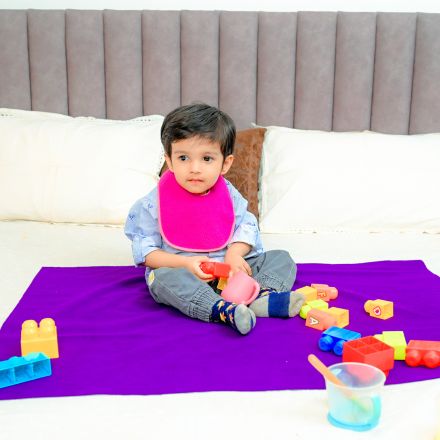When you become a parent, there’s one item you quickly discover is an absolute lifesaver—baby bibs. These small, yet incredibly practical accessories help protect your little one’s clothes from spills, drools, and the messiness of mealtime. While bibs are crucial, they also need to be kept soft and absorbent to do their job properly. Unfortunately, over time, bibs can lose their plushness and absorbency due to multiple washes, frequent exposure to food stains, and the wear and tear that comes with constant use. However, with the right care techniques, you can keep them in great condition for longer. Let’s dive into some tips that will help you maintain those beloved baby bibs, making sure they stay soft and absorbent even after countless washes.
Understanding the Fabric’s Role in Softness and Absorbency
Before we dive into the how-to of maintaining baby bibs, it’s important to understand why some bibs lose their softness and absorbency over time. Many baby bibs are made from cotton, a fabric prized for its softness, absorbency, and durability. However, cotton fibers can become stiff or lose their absorbent qualities when exposed to harsh detergents, hot water, or high heat during drying. Additionally, many baby bibs are lined with materials like fleece or terry cloth, which offer extra absorbency but may need additional care to maintain their plushness.
Choose the Right Detergent
One of the key steps in keeping baby bibs soft and absorbent is choosing the right detergent. Harsh chemicals in traditional laundry detergents can strip away the natural oils in fabrics like cotton, making them stiff and rough. To keep your baby’s bibs soft, opt for a gentle, baby-safe detergent free from artificial fragrances, dyes, and harsh chemicals. There are plenty of detergents on the market specifically formulated for baby clothes, and these tend to be much gentler on fabrics while still providing a deep clean.
Another helpful tip is to avoid using fabric softeners, especially the liquid kind. Fabric softeners may make the fabric feel soft initially, but they can leave behind a waxy residue that diminishes the bib’s absorbency. This can be a problem, as the bib won’t soak up as much drool or food during mealtime, defeating the purpose of using it in the first place.
Wash with Care: Temperature Matters
When it comes to washing baby bibs, water temperature plays a crucial role. Hot water, while great for sanitizing, can actually break down cotton fibers over time, causing them to lose their softness. Instead of using hot water, wash your baby’s bibs in cold or lukewarm water. This helps to preserve the integrity of the fabric and ensures that your bibs stay soft and absorbent.
If your baby bibs are particularly soiled or stained, you can try a pre-soak in cold water with a gentle stain remover before washing them. This will lift out stains without the need for harsh detergents or high temperatures. Additionally, be sure to zip up any snaps or Velcro before washing to prevent them from snagging the fabric and causing damage.
Drying Techniques: Air Dry or Low Heat
Drying baby bibs properly is just as important as washing them. While tossing them in the dryer might seem like the quickest and easiest option, high heat can actually damage the fabric, making it stiff and rough. It can also cause any fleece or terry cloth lining to lose its plushness. To keep your bibs soft and absorbent, air-drying them is the best option. Simply hang them up on a clothesline or lay them flat to dry. This method preserves the fabric and ensures that it remains in great condition after every wash.
If you’re in a rush and need to use the dryer, choose a low heat setting. This helps prevent the cotton from shrinking or becoming stiff while still allowing you to get your bibs dried in a reasonable amount of time. To make sure your bibs stay extra soft, toss in a dryer ball or clean tennis ball to fluff them up during the drying cycle.
Avoid Over-Washing
It might seem like you need to wash your baby’s bibs after every use, but over-washing can actually contribute to the degradation of their softness and absorbency. If a bib has only been lightly soiled, it may be enough to wipe it down with a damp cloth or sponge. Over time, frequent washing can break down the fabric and cause it to lose its plush, absorbent qualities. Instead, save washes for when they are actually necessary, such as when the bib is visibly soiled or has absorbed a lot of moisture.
Give Your Bibs a Gentle Massage
If you notice that your baby’s bibs are feeling a little rough or stiff, you can try giving them a gentle massage to help restore their softness. After washing and drying, rub the fabric between your hands to help loosen up any fibers that may have clumped together. This technique works wonders for bibs that are starting to feel a little stiff but are still in otherwise good condition.
Keep an Eye on the Stains
Food stains are an inevitable part of using baby bibs. However, certain stains can be tough to get rid of if they’re not treated properly. While regular washing helps, it's important to address stains as soon as possible to prevent them from setting. To treat stains, try soaking the bib in a mixture of cold water and a natural stain remover, like baking soda or vinegar. Let it sit for a few minutes before washing as usual. This will help preserve both the softness and the absorbency of the bib while removing stubborn stains.
Invest in Quality Bibs
While proper care is key, the quality of the bib itself plays a significant role in how long it stays soft and absorbent. Invest in bibs made from high-quality materials, as they are likely to hold up better over time. Brands like Happy Matty, for example, focus on offering durable, soft, and absorbent bibs that are designed with your baby’s comfort in mind. Their products are made from premium fabrics that ensure your baby stays dry, comfortable, and stylish during mealtime.
Happy Matty’s bibs are designed not only for superior absorbency but also to stay soft even after multiple washes. When you choose bibs from a trusted brand like this, you’re making an investment in the long-term quality and performance of the product. Plus, Happy Matty’s commitment to quality means that you won’t have to worry about your bibs losing their absorbency after a few washes.
The Importance of Gentle Care
Above all, when it comes to keeping your baby bibs soft and absorbent, gentle care is essential. Babies have sensitive skin, and the last thing you want is a bib that’s too harsh or rough for them to wear comfortably. That’s why it’s worth taking the extra time to ensure that your bibs are treated with the same care you would give your baby’s clothes. By following the tips outlined above and choosing quality bibs, you can ensure that your little one stays clean and comfortable while you enjoy those sweet mealtimes together.
Suggested Reading: How Play Tents Encourage Independent Play and Social Skills
Conclusion
Baby bibs are more than just a practical accessory; they’re an essential part of a parent’s daily routine. Keeping them soft and absorbent after multiple washes doesn’t have to be a challenge. By choosing the right detergent, washing in cold water, avoiding over-drying, and using gentle care techniques, you can extend the life of your bibs and keep them in top condition for as long as possible. Don’t forget to invest in high-quality bibs that will perform well over time—brands like Happy Matty offer bibs that are designed to withstand repeated washes while maintaining their softness and absorbency. With a little care and attention, your baby’s bibs can continue to be a reliable, soft, and absorbent part of your mealtime routine for months to come.
If you're in need of high-quality baby bibs, be sure to check out Happy Matty for durable, soft, and absorbent bibs designed with your little one in mind.



